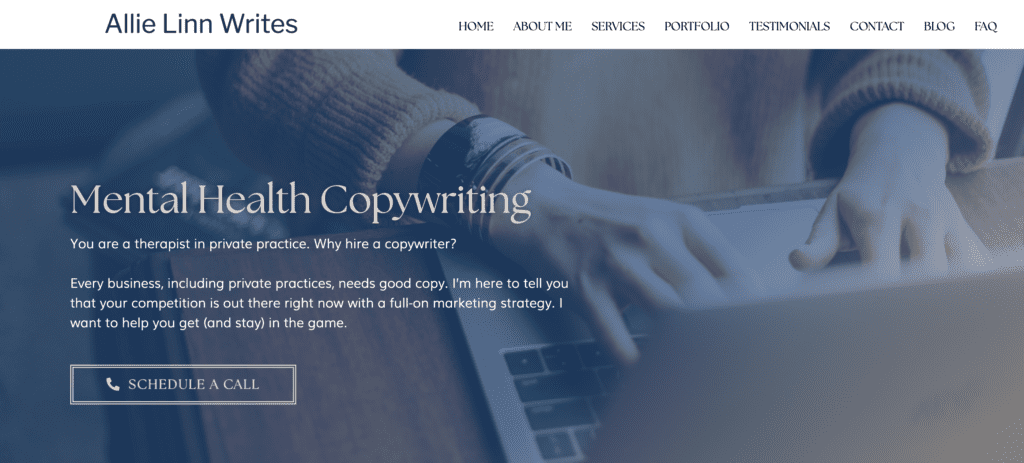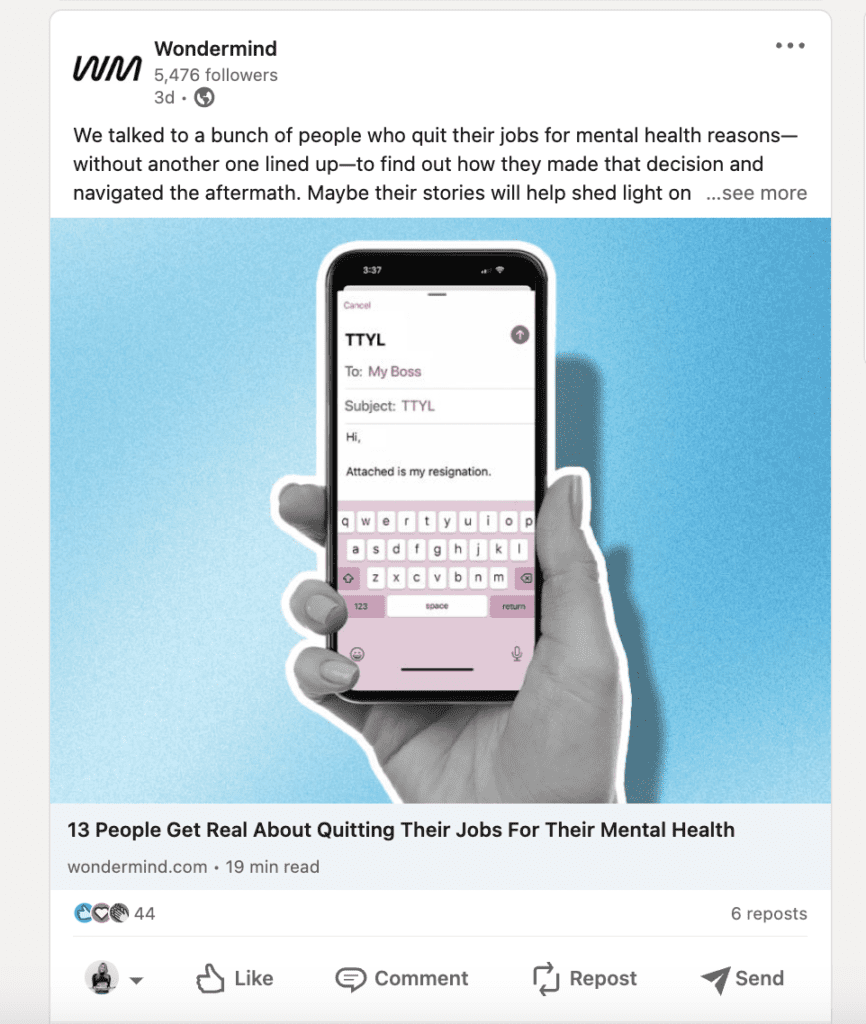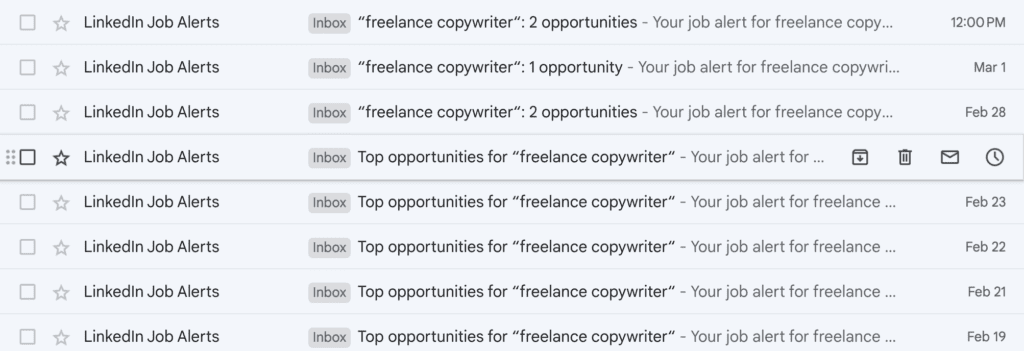If you want to use your passion for mental health to become a highly paid writer, there’s never been a better time. In the past few years, 50 million Americans have reported experiencing mental illness.
With therapy inaccessible to many, writing in the mental health space is a huge opportunity to impact lives while building a lucrative career.
Whether you have real-life experience in this industry or personal experiences that make you nerd out on mental health, you can create a high-paying freelance business with the right combination of knowledge and writing skills.
In this guide, I’ll provide all the information you need to get started on your journey as a mental health writer.
What is a mental health writer?
Mental health writers create content related to mental health. They write articles, blog posts, e-books, and other web-based content on depression, anxiety, stress management, therapy, and self-care.
They also provide advice and tips about reducing negative mental health effects. Mental health writers use research to inform their readers on these topics accurately. Their ultimate goal is to help people live healthier lives through education and understanding.
In addition to being well-versed in the scientific facts of mental health topics, mental health writers should also have a compassionate understanding of how this information affects individuals’ daily lives and how they can best cope with their issues.
Mental health knowledge can come from researching the literature, personal experiences, and interviews with others who have experienced similar issues. Writing about mental health is ultimately about creating accurate and accessible content for people coping with their own mental health concerns or those of someone close to them.
How do I become a mental health writer?
Writing about mental health requires knowledge of psychology, psychiatry, and other related sciences. However, the question to get started in this field should be how do I launch a freelance business? Versus How do I become a mental health writer?
Logically, your first step to becoming a writer might be to take writing courses. However, you do not need a special certificate or degree to become a writer. Many copywriters and content writers are self-taught and learn by doing.
Most copywriters think they must take a course and learn everything before marketing their services and searching for paid writing opportunities. They use “not knowing enough” or “not feeling ready” as a procrastination tool to avoid doing the hard part of a freelance business: getting clients.
I know it sounds entirely backward to get writing clients and focus on the business aspects first, but the reality is that no online course will 100% prepare you because each client will want something different from you.
Beyond basic writing skills and principles, this is a “learn as you go” profession. However, online courses are valuable if you want the information packaged engagingly with a community and mentorship component.
The following steps will help you start your freelance mental health writing business quickly.
Step 1: Set up your writer’s website
Having your own website as a freelance writer is critical for a few reasons:
- You’re not just a freelancer. You’re a business. Businesses have websites.
- To present yourself professionally.
- Clients use the information on your website to determine if you’re the right fit.
I understand if the idea of building a writer’s website is overwhelming. I didn’t even know what a web domain was when I got into freelancing, and I had certainly never built a website. Despite being a total beginner, it took about a week for me to build my site. Luckily I went with cheap web hosting through Bluehost and an easy drag-and-drop site builder, Weebly.
You’ll need:
- Your own website with a portfolio page
- Your own website domain (meaning: yourwebsitename.com)
- Your own email domain (having @gmail.com doesn’t look as professional.

Step 2: Tailor your online presence to appeal to mental health clients
Tailor your online presence and marketing toward your ideal clients and their pain points and goals. Tailoring your marketing messages toward your ideal clients will help you stand out as a professional in your niche.
By taking the time to understand what makes your ideal clients tick, you’ll create content and services that speak directly to those needs. It also positions you as a solutions-providers rather than just another writer looking for work.
Finally, tailoring your online presence and marketing toward your ideal client’s pain points allows you to capitalize on opportunities by targeting clients at the right time. This means understanding when a particular pain point is most relevant (like during a pandemic) or the release of a new product (like ChatGPT) that could benefit from some targeted content.
This approach also provides an opportunity to offer additional services such as editing or ghostwriting on top of writing services to meet any additional needs that arise from researching potential projects or topics related to your area of expertise.
Step 3: Freelance optimize your LinkedIn profile
Having freelance-optimized social media profiles gives you access to a wider range of potential customers and increases your visibility and chances of getting hired. Create a professional-looking profile tailored towards potential clients, highlighting your experience, skills, qualifications, and any awards or recognition received.
LinkedIn is your best friend for landing freelance clients. It’s the world’s fourth most popular social network, with over 450 million members. If done correctly, your LinkedIn profile will win over clients and do most of the selling on your behalf.
Over 50% of a client’s decision is made before connecting with the person who will provide them with the necessary goods or services. This makes LinkedIn one of your most valuable marketing tools.
Your LinkedIn profile is one of the easiest ways for clients to find YOU. While you’ll need to send high volume cold pitches and LOIs initially, clients will eventually come to you if you optimize your profile with the right keywords.
Step 4: Make a list of companies and brands that publish mental health content
When freelance health writers are looking for clients, one of the best ways for them to start is by creating a list of companies to reach out to. Who do you want to write for? Who are your ideal clients? It’s critical to answer these questions before you try to get clients. Unfortunately, many freelancers miss this step.

When building your list of prospective clients, quickly research the companies you’re considering. Writers should understand the company’s products and services, their target audience, and what kind of content they need. Not only will your list help you focus on your efforts to get better results, but it will also help you keep track of who you’ve contacted so you can follow up later.
It’s also helpful to find out how big the company is and gauge whether or not they’re producing content or needs content. Do they have a blog, a newsletter, or a resources tab on their website? These are all clues that they’re prioritizing content creation and will likely be interested in hiring you as a health writer.
Step 5: Begin cold pitching your ideal clients
Cold pitching is an essential tactic for any freelance health writer looking to secure work. Pitching means directly contacting potential clients with an introduction and short proposal that outlines the value you can bring to their project. Cold pitching can be done through email, on social media, or in person if you know someone who can refer you.
If you’re starting your freelance business from scratch or have no professional writing experience, cold-pitching and sending letters of introduction (LOIs) is the main client acquisition strategy you should pursue. The platform you’ll use to contact prospective clients will vary based on where your ideal clients hang out.
Are they active on LinkedIn, Twitter, or other social platforms? If not, email will be your best bet.
Using a social platform (like LinkedIn) to cold pitch is easier because you don’t have to find email addresses or publish your blog or social posts.
There’s so much bad advice about ” organically engaging ” and jumping through hoops to get a client’s attention without reaching out to them directly. People will tell you it’s sleazy, sales-y, or a bad business practice. However, this couldn’t be further from the truth.
If you’re hesitant about sending clients cold messages, let me remind you:
- You are not a telemarketer calling someone in the middle of dinner.
- You are not an MLM boss babe asking someone to join your pyramid scheme.
- Offering your copywriting services to needy marketers does NOT make you sleazy!
Remember, the clients you’re messaging are already tasked with searching LinkedIn and other platforms to hire writers. You’re just being proactive and placing yourself in their line of sight.
If you’ve never cold pitched before, I suggest you find templates to help you get started: download The Freelance Template Playbook 📓™️
Step 6: Use LinkedIn to network with mental health brands
Since many aspiring freelance writers have no sales experience, LinkedIn for social selling can a breath of fresh air. It doesn’t feel as “spammy” as cold emailing. On top of cold pitching, LinkedIn lets you engage clients more authentically.
For example, instead of sending follow-up messages, you can “like” or comment on activities to remain on their radars. Who doesn’t like receiving engagement on their posts?
Plus, unlike a wall of text in an email, your prospect will immediately see your complete LinkedIn profile, increasing your visibility. Plus, LinkedIn is more personal than getting an email.
While it will take a lot of cold outreach on your part initially, clients will eventually start coming if you optimize your profile with the right keywords. In my free guide, A Step-by-Step Roadmap for Getting Started as a Freelance Copywriter, I explain how to create your LinkedIn profile and increase your chances of being found.
Step 7: Sign up for writing job alerts
One of the easiest steps to get clients is to sign up for job alerts on popular freelance websites. Doing so ensures you can access the latest job opportunities and send them directly to your inbox.
In addition to providing access to a larger number of job opportunities, signing up for alerts can also help save time when searching through postings manually. Instead of sifting through pages of posts, you’ll simply receive notifications with all relevant information included so you can apply within minutes rather than hours.
Most major job sites have an automated email feature to send writing-related opportunities to your inbox. For example, sites like remote.co will email you free listings weekly. Also, you can sign up for job alerts on LinkedIn.

Where to find freelance clients as a mental health writer
You can find freelance mental health writing jobs on various websites, directories, and job boards. At first, you will have to trial and error to find the best strategy for you. At first, it may seem overwhelming, but don’t give up. Eventually, you’ll realize where you get the most responses and the best pay.
Network in mental health groups:
Join and network with other mental health writers online or through professional organizations like Mental Health America or the American Psychological Association. Doing this will help you learn from their experiences and build relationships with potential clients.
Apply to mental health publications:
Pro tip: If there’s a mental health website you want to write for, use the search term “write for [COMPANY NAME], and you’ll usually find their submission guidelines.
How much do freelance mental health writers make?
The median annual pay for freelance copywriters is between $49,622 and $61,839. Ultimately, how much you make as a freelance writer depends on how you set your rates and how many clients agree to those rates.
“How much do I charge for this?” This will forever be one of the most asked questions by new freelancers. Mainly because the answer is always “it depends,” which is an infuriating answer for someone who just wants to know how much to charge.
I’ll share the most common ways to set your rates, and you should choose what works best for you based on your clients and your experience. However, remember that freelance rates will be trial and error initially and that they’re never fixed.
You will raise your freelance rates as you go, so you must remain adaptable when pricing and realize that setting your rates is an ongoing challenge.
- Use free industry reports
I used AWAI’s free report to set my rates. While they only provide price ranges, it still helped me tremendously. I credit that free report for why I never charged less than $400 for a blog, even as a beginner.
- Use calculators
If you like the math side of things, pricing calculators take several different factors into account to help you set your prices.
- Copywriting Course free pricing calculator
- Freelance Copywriter Quote Calculator
- All Freelance Writing Freelance Hourly Rate Calculator
- Use equations
Income goal method:
When I finally got a steady client workload and understood how much I could charge, I switched my method from the AWAI industry report to the income goal method. The income goal method requires setting your income goal and working backward.
For example, you decide how much it costs to cover your basic expenses, divide that into what you need to earn a month, then set your rates to increase the chances of you hitting that monthly goal.
This method comes in handy when I’m tempted to take lower-paying clients and reminds me that I quite literally cannot afford to and keeps me “holding out” for the higher-paying clients.
Value-based pricing:
Value-based pricing is a pricing model used by freelancers and other professionals that sets your rates based on the value provided to the client. This model allows freelancers to charge more for services that bring greater value, such as complex projects that require more expertise and experience.
With this pricing model, freelancers are rewarded for providing higher quality work, allowing them to make more money in the long run.
For example, let’s say you’re a freelance and you’re writing a website for a client. You could structure your prices based on how much coordination time it will require with other team members like designers and developers.
Also, if you know the product they’re selling will produce $5,000 from one sale, you can charge based on the amount you know the page will convert for the client. The extra time spent crafting and the know-how that comes with producing higher-quality work brings more value to the client, so it makes sense for the client to compensate you accordingly.
Hourly to flat equation:
Once you’ve done enough writing work, you’ll get a general idea of how long it will take to complete certain projects. In this equation, you convert each project to an hourly rate based on the estimated number of hours it will take to complete.
For example, my typical hourly rate is $100 and up, so with simple division, I can quickly determine whether the hourly rate is $100 or $600, or somewhere in between.
- Find out what other freelancer writers charge
You can determine the appropriate rate for each project by comparing it with what other freelance copywriters charge for similar work. This helps you ensure you’re not undercharging or overcharging for your services and helps establish yourself as a competent and competitive provider.
Being part of a Facebook or Slack community helps see what other writers charge as they tend to be more transparent in closed groups. The downside of this strategy is that many freelance writers tend to undercharge, so comparing rates isn’t always reliable.
- Ask the client what their budget is
It’s a last resort, but if you’re new to copywriting and aren’t sure what to charge and can’t find the answer, you could let the client decide.
While this is not ideal because you’re not a proactive business owner, you can use this information to gauge what clients expect to pay and spot the patterns. Also, if you find out you’re being grossly underpaid, you can always raise your prices or drop the client.
Conclusion
The journey to becoming a freelance mental health writer can be long and difficult, but the rewards are worth it. With research, practice, and hard work, you’ll find yourself in a place where you can confidently craft engaging stories about mental health topics.
By setting up your online presence correctly, you’ll quickly build trust with freelance clients and get into the mindset of a business owner. Take advantage of strategies like cold pitching and resources like job boards and networking events to get started as a successful freelance mental health writer.
As a freelance mental health writer, you can share your voice and help others feel understood. It won’t be easy. There will be setbacks. But with persistence and resilience, you can make your mark as a trusted mental health writer.
👉🏼Ready to start your career as a mental health writer? With the right know-how, you can land high-paying writing gigs that make a difference.
Let's Connect!